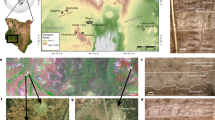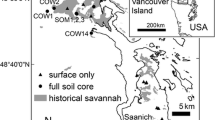Abstract
Background and aims
Seasonally flooded South American savannas harbor different kinds of mound-field landscapes of largely unknown origin. A recent study used soil carbon-isotope depth profiles and other proxies to infer vegetation history in murundu landscapes in Brazil. Results suggested that differential erosion, not building-up processes (e.g., termite mounds), produced mounds. We tested this approach to inferring mound origin in a mound-field landscape in French Guiana.
Methods
We examined carbon-isotope depth profiles of soil organic matter, phytolith profiles and contemporary vegetation composition in mounds and inter-mounds.
Results
Relative abundance of C3 and C4 plants across habitats was very different from that in murundu landscapes; C3 plants were better represented in inter-mounds than on mounds. Habitat differences in C3/C4 distribution were subtler than in murundu landscapes, limiting inference of vegetation history based on carbon isotopes. Still, carbon-isotope and phytolith depth profiles gave similar pictures of vegetation history, both favoring a building-up hypothesis, corroborating other evidence that these mounds are vestiges of ancient agricultural raised fields.
Conclusions
Carbon-isotope depth profiles are unlikely to be adequate for deciphering origin of mound-field landscapes from vegetation history in seasonally flooded savannas. Including data on current vegetation and phytoliths makes inferences more robust.







Similar content being viewed by others
Abbreviations
- NMDS:
-
Non-metric multidimensional distance scaling analysis
- MANOVA:
-
Non-parametric multivariate analysis of variance
- SD:
-
Standard deviation
- SOM:
-
Soil organic matter
References
Balesdent J, Mariotti A (1996) Measurement of soil organic matter turnover using 13C natural abundance. In: Boutton TW, Yamasaki S (eds) Mass spectrometry of soils. Dekker, New York, pp 83–111
Barret J (2001) Atlas illustré de la Guyane. Editions IRD, Paris
Bates M (1948) Climate and vegetation in the Villavicencio region of eastern Colombia. Geogr Rev 38:555–574
Beard JS (1953) The savanna vegetation of northern tropical America. Ecol Monogr 23:149–215
Bird MI, Pousai P (1997) Variations of δ13C in the surface soil organic carbon pool. Global Biogeochem Cy 11:313–322
Bloesch U (2008) Thicket clumps: a characteristic feature of the Kagera savanna landscape, East Africa. J Veg Sci 19:31–44
Boutton TW (1996) Stable carbon isotope ratios of soil organic matter and their use as indicators of vegetation and climate change. In: Boutton TW, Yamasaki S (eds) Mass spectrometry of soils. Dekker, New York, pp 47–82
Boutton TW, Archer SR, Midwood AJ, Zitzer SF, Bol R (1998) δ13C values of soil organic carbon and their use in documenting vegetation change in a subtropical savanna ecosystem. Geoderma 82:5–41
Bråthen KA, Hagberg O (2004) More efficient estimation of plant biomass. J Veg Sci 15:653–660
Buol SW, Southard RJ, Graham RC, McDaniel PA (2003) Soil genesis and classification, 5th edn. Iowa State Press, USA
Calatayud PA, Barón CH, Velásquez H, Arroyave JA, Lamaze T (2002) Wild Manihot species do not possess C4 photosynthesis. Ann Bot-London 89:125–127
Chacón-Moreno EJ, Naranjo ME, Acevedo D (2004) Direct and indirect vegetation-environment relationships in the flooding savanna of Venezuela. Ecotropicos 17:25–37
Chacón-Moreno EJ, Smith JK, Skidmore AK, Hebert HT, Prins TAG (2007) Modelling spatial patterns of plant distribution as a consequence of hydrological dynamic processes in a Venezuelan flooding savanna. Ecotropicos 20:55–73
Cox GW, Lovegrove BG, Siegfried WR (1987) The small stone content of mima-like mounds in the South African Cape Region—implications for mound origin. Catena 14:165–176
Craig H (1953) The geochemistry of stable carbon isotopes. Geochemica Cosmochemica Acta 3:53–92
Denevan WM (2001) Cultivated Landscapes of Native Amazonia and the Andes. Oxford University Press, New York
Diniz de Araújo Neto M, Neto M, Furley PA, Haridasan M, Johnson CE (1986) The murundus of the cerrado region of Central Brazil. J Trop Ecol 2:17–35
Dray S, Dufour AB (2007) The ade4 package: implementing the duality diagram for ecologists. J Stat Softw 22:1–20
Ehleringer JR, Buchmann N, Flanagan LB (2000) Carbon isotope ratios in belowground carbon cycle processes. Ecol Appl 10:412–422
Fall S, Brauman A, Chotte JL (2001) Comparative distribution of organic matter in particle and aggregate size fractions in the mounds of termites with different feeding habits in Senegal: Cubitermes niokoloensis and Macrotermes bellicosus. Appl Soil Ecol 17:131–140
FAO (1998) World reference base for soil resources. World Soil Resources Report no. 84. Rome.
Fishkis O, Ingwerseon J, Lamers M, Denysenko D, Streck T (2010) Phytolith transport in soil: a field study using fluorescent labelling. Geoderma 157:27–36
Folgarait PJ (2002) Effects of Camponotus punctulatus ants on plant community composition and soil properties across land-use histories. Plant Ecol 163:1–13
Folgarait PJ, Perelman S, Gorosito N, Pizzio R, Fernandez J (2002) Effects of Camponotus punctulatus ants on plant community composition and soil properties across land-use history. Plant Ecol 163:1–13
Froidefond JM, Lahet F, Hu C, Doxaran D, Guiral D, Prost MT, Ternon JF (2004) Mudflats and mud suspension observed from satellite data in French Guiana. Mar Geol 208:153–168
Giussani LM, Cota-Sanchez JH, Zuloaga FO, Kellogg EA (2001) A molecular phylogeny of the grass subfamily Panicoideae (Poaceae) shows multiple origins of C4 photosynthesis. Am J Bot 88:1993–2012
Glaser B (2005) Compound-specific stable-isotope (δ13C) analysis in soil science. J Plant Nutr Soil Sc 168:633–648
Glaser B (2010) Variations of abundances of carbon isotopes in nature. In: Beauchemin D, Matthews D (eds) Encyclopedia of mass spectrometry vol 5: Elemental, isotopic and inorganic analysis by mass spectrometry. Elsevier, Amsterdam, in press
Hanagarth W (1993) Acerca de la geoecología de las sabanas del Beni en el Noreste de Bolivia. Instituto de Ecología, La Paz
Iriarte J, Alonso Paz E (2009) Phytolith analysis of selected native plants and modern soils from southeastern Uruguay and its implications for paleoenvironmental and archeological reconstruction. Quater Int 193:99–123
Iriarte J, Glaser B, Watling J, Wainwright A, Birk JJ, Renard D, Rostain S, McKey D (2010) Late Holocene Neotropical agricultural landscapes: phytolith and stable carbon isotope analysis of raised fields from French Guianan coastal savannahs. J Archaeol Sci 37:2984–2994
IUSS Working Group WRB (2006) World reference base for soil resources 2006. FAO, Rome
Jonasson S (1988) Evaluation of the point intercept method for the estimation of plant biomass. Oikos 52:101–106
Jouquet P, Lepage M, Velde B (2002) Termite soil preferences and particle selections: strategies related to ecological requirements. Insectes Soc 49:1–7
Klink CA, Joly CA (1989) Identification and distribution of C3 and C4 grasses in open and shaded habitats in São Paulo State, Brazil. Biotropica 21:30–34
Krull ES, Skjemstad JO (2003) δ13C and δ15N profiles in 14C-dated oxisol and vertisols as a function of soil chemistry and mineralogy. Geoderma 112:1–29
Krull ES, Bestland EA, Gates WP (2002) Soil organic matter decomposition and turnover in a tropical ultisol: evidence from δ13C, δ15N and geochemistry. Radiocarbon 44:93–112
Mayle FE, Langstroth RP, Fisher RA, Meir P (2007) Long-term forest-savannah dynamics in the Bolivian Amazon: implications for conservation. Philos T Roy Soc B 362:291–307
McCarthy TS, Ellery WN, Dangerfield JM (1998) The role of biota in the initiation and growth of islands on the floodplain of the Okavango alluvial fan, Botswana. Earth Surf Proc Land 23:291–316
McClaran MP, Umlauf M (2000) Desert grassland dynamics estimated from carbon isotopes in grass phytoliths and soil organic matter. J Veg Sci 11:71–76
McKey D, Rostain S, Iriarte J, Glaser B, Birk JJ, Holst I, Renard D (2010) Pre-Columbian agricultural landscapes, ecosystem engineers, and self-organized patchiness in Amazonia. P Natl Acad Sci USA 107:7823–7828
Medina E, Motta N (1990) Metabolism and distribution of grasses in tropical flooded savannas in Venezuela. J Trop Ecol 6:77–89
Midgley JJ (2010) More mysterious mounds: origins of the Brazilian campos de murundus. Plant Soil 336:1–2
Moore JM, Picker MD (1991) Heuweltjies (earth mounds) in the Clanwilliam district, Cape Province, South Africa: 4000-year-old termite nests. Oecologia 86:424–432
Oksanen J, Kindt R, Legendre P, O’Hara B, Henry M, Stevens H (2007) Vegan: Community Ecology Package. R package
Oliveira-Filho AT (1992) Floodplain ‘mounds’ of central Brazil: evidence for the termite origin hypothesis. J Trop Ecol 8:1–19
Pessenda LCR, Aravena R, Melfi AJ, Telles ECC, Boulet R, Valencia EPE, Tomazello M (1996) The use of carbon isotopes (13C, 14C) in soil to evaluate vegetation changes during the Holocene in central Brazil. Radiocarbon 38:191–201
Piperno DR (1988) Phytolith analysis: an archaeological and geological perspective. Academic, San Diego
Piperno DR (2006) Phytoliths. A comprehensive guide for archaeologists and paleoecologists. Altamira Press, San Diego
Ponce VM, Da Cunha CN (1993) Vegetated earthmounds in tropical savannas of Central Brazil: a synthesis. J Biogeogr 20:219–225
Prost MT (1989) Coastal dynamics and chenier sands in French Guiana. Mar Geol 90:259–267
R Development Core Team (2004) R: A language and environment for statistical computing. R foundation for Statistical Computing, Vienna
Reichel-Dolmatoff G, Reichel-Dolmatoff A (1974) Un sistema de agricultura prehistórica de los Llanos Orientales. R Colomb Antr 17:189–200
Reichman OJ, Seabloom EW (2002) The role of pocket gophers as subterranean ecosystem engineers. Trends Ecol Evol 17:44–49
Römbke J, Zicsi A (2007) Present state of knowledge of earthworm ecology and taxonomy in Bolivia. Earthworms from South America 41. In: Brown GG, Fragoso C (eds) Minhocas na América Latina: Biodiversidade e Ecologia. Embrapa, Londrina, pp 217–228
Röttgermann M, Steinlein T, Beyschlag W, Dietz H (2000) Linear relationships between aboveground biomass and plant cover in low open herbaceous vegetation. J Veg Sci 11:145–148
Sage R (2004) The evolution of C4 photosynthesis. New Phytol 161:342–370
Sage RF, Kubien DS (2003) Quo vadis C4? An ecophysiological perspective on global change and the future of C4 plants. Photosynth Res 77:209–225
Sarmiento G, Pinillos M (2001) Patterns and processes in a seasonally flooded tropical plain: the Apure Llanos, Venezuela. J Biogeogr 28:985–996
Silva LCR, Sternberg L, Haidar RF, Vale GD (2010) Deciphering earth mound origins in central Brazil. Plant and Soil 336:3–14
Ueno O, Koyama T (1987) Distribution and evolution of C4 syndrome in Rhynchospora (Rhynchosporeae – Cyperaceae). Bot Mag Tokyo 100:63–85
Wynn JG (2007) Carbon isotope fractionation during decomposition of organic matter in soils and paleosols: Implications for paleoecological interpretations of paleosols. Palaeogeogr Palaeocl 251:437–448
Wynn JG, Bird MI, Wong VNL (2005) Rayleigh distillation and the depth profile of 13C/12C ratios of soil organic carbon from soils of disparate texture in Iron Range National Park, Far North Queensland, Australia. Geochim Cosmochim Ac 69:1961–1973
Zhang H, Schrader S (1993) Earthworm effects on selected physical and chemical properties of soil aggregates. Biol Fertil Soils 15:229–234
Acknowledgements
This study was funded by two interdisciplinary programs of the CNRS (INEE, Institut National Ecologie et Environnement) “Amazonie” and “Ingénièrie Ecologique”. Personnel of the laboratory EcoFog (UMR L3MA, CNRS) in Kourou provided logistical assistance. Marie-Françoise Prévost is thanked for her help with plant determinations at CAY. Bruno Roux (L’AvionJaune, Montpellier) taught DR how to use Pixy™. We thank Dr. J. Römbke (ECT Oekotoxikologie, Flörsheim, Germany) for permission to use the photo of earthworm towers (sartenejales) reproduced in Fig. 1e. Stable isotopes were measured at Bayreuth Center of Ecology and Environmental Research (BayCEER) in the Laboratory of Isotope Biogeochemistry. We thank Finn Kjellberg (CNRS, Montpellier), Marc-André Selosse (University of Montpellier), Leonel Sternberg (University of Miami) and two anonymous reviewers for their critical comments on drafts of the manuscript.
Author information
Authors and Affiliations
Corresponding author
Additional information
Responsible Editor: Hans Lambers.
Rights and permissions
About this article
Cite this article
Renard, D., Birk, J.J., Glaser, B. et al. Origin of mound-field landscapes: a multi-proxy approach combining contemporary vegetation, carbon stable isotopes and phytoliths. Plant Soil 351, 337–353 (2012). https://doi.org/10.1007/s11104-011-0967-8
Received:
Accepted:
Published:
Issue Date:
DOI: https://doi.org/10.1007/s11104-011-0967-8




